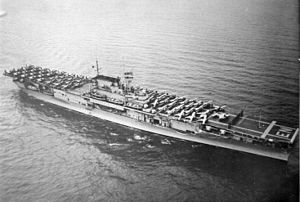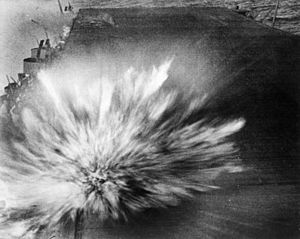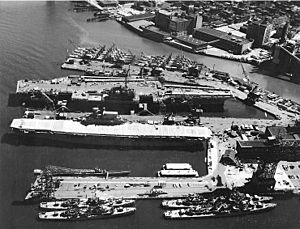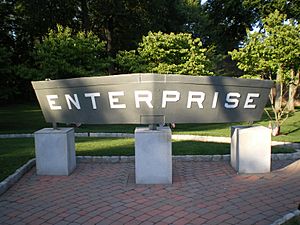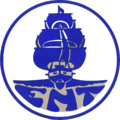USS Enterprise (CV-6) facts for kids
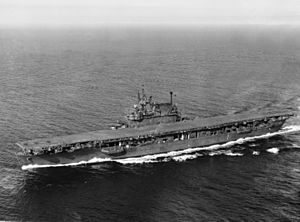
Aerial view of Enterprise at sea in 1945
|
|
Quick facts for kids History |
|
|---|---|
| Name | USS Enterprise |
| Ordered | 1933 |
| Builder | Newport News Shipbuilding |
| Laid down | 16 July 1934 |
| Launched | 3 October 1936 |
| Commissioned | 12 May 1938 |
| Decommissioned | 17 February 1947 |
| Identification | Hull number: CV-6 |
| Nickname(s) | The Big E
Lucky E The Grey Ghost The Galloping Ghost |
| Honors and awards |
|
| Fate | Scrapped 1958–1960 |
| General characteristics (as built) | |
| Class and type | Yorktown-class aircraft carrier |
| Displacement |
|
| Length |
|
| Beam |
|
| Draft | 25 ft 11.5 in (7.9 m) |
| Installed power |
|
| Propulsion | 4 × shafts; 4 × Parsons geared steam turbines |
| Speed | 32.5 knots (60.2 km/h; 37.4 mph) |
| Range | 12,500 nmi (23,200 km; 14,400 mi) at 15 knots (28 km/h; 17 mph) |
| Complement | 2,217 officers and men (1941) |
| Sensors and processing systems |
CXAM-1 RADAR |
| Armament |
|
| Armor |
|
| Aircraft carried | 90 aircraft |
| Aviation facilities |
|
USS Enterprise (CV-6), often called the "Big E," was a famous aircraft carrier of the United States Navy. She was the sixth aircraft carrier and the seventh U.S. Navy ship to have this name. Launched in 1936, she was a Yorktown-class carrier. She was one of only three American carriers that survived World War II.
Enterprise fought in more battles against Japan than any other U.S. ship. These battles included the Battle of Midway, the Battle of the Eastern Solomons, and the Battle of the Santa Cruz Islands. She also fought in many other battles during the Guadalcanal campaign, the Battle of the Philippine Sea, and the Battle of Leyte Gulf. The Japanese mistakenly reported her sunk three times during the war. This earned her the nickname "The Grey Ghost."
Enterprise received 20 battle stars, more than any other U.S. warship in World War II. Many people consider her the most honored ship in U.S. Navy history. Only the 18th-century frigate USS ''Constitution'' might be able to rival her fame.
Building the Big E
Enterprise was launched on October 3, 1936. This happened at Newport News Shipbuilding in Virginia. Lulie Swanson, the wife of the Secretary of the Navy Claude A. Swanson, was her sponsor. A sponsor is someone who officially names and launches a ship.
Enterprise was officially put into service, or commissioned, on May 12, 1938. After testing her performance in places like Rio de Janeiro, she worked along the U.S. east coast and in the Caribbean. In April 1939, she was sent to serve in the Pacific Ocean.
Enterprise in Action
Enterprise was one of the first ships to get the RCA CXAM-1 RADAR system. She was first based in San Diego and later at Pearl Harbor. This move happened after President Roosevelt ordered the fleet to be based further forward.
Enterprise and her aircraft crews trained a lot. They also moved aircraft between the Pacific island bases. On November 28, 1941, Enterprise left Pearl Harbor. She was on a mission to deliver Marine Fighter Squadron 211 (VMF-211) to Wake Island.
World War II Begins
The Attack on Pearl Harbor
On December 7, 1941, Enterprise was returning to Oahu. While the Japanese were attacking Pearl Harbor, 18 SBD Dauntless planes from Enterprise arrived. These planes were from Scouting Squadron Six (VS-6) and Bombing Squadron Six (VB-6). Even though they were surprised, they quickly joined the fight to defend Pearl Harbor.
VS-6 lost six planes during the attack, and VB-6 lost one. Many were shot down by the Japanese. However, at least one plane was lost to friendly anti-aircraft (AA) fire. Many more planes were damaged.
Enterprise also launched six F4F Wildcat planes from Fighting Squadron Six (VF-6). Most of these were shot down by confused AA gunners when they tried to land later that night. After the attack, Enterprise searched for the Japanese force. She refueled at Pearl Harbor on December 8 and then patrolled the Hawaiian Islands. Although no ships were found, Enterprise aircraft sank the Japanese submarine I-70 on December 10, 1941.
For the rest of December 1941, Enterprise protected the Hawaiian Islands. After a short rest, she left on January 11, 1942. She protected ships bringing aid to Samoa. On February 1, Enterprise's Task Force 8 attacked Kwajalein, Wotje, and Maloelap in the Marshall Islands. They sank three ships and destroyed many aircraft.
Midway: A Turning Point
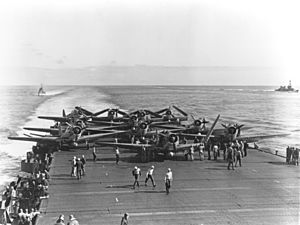
Five days later, Enterprise sailed to the South Pacific to help other U.S. carriers. However, the Battle of the Coral Sea was over before she arrived.
On May 28, Enterprise moved to Midway. She was the flagship for Rear Admiral Raymond A. Spruance. Her mission was to defend Midway and cause as much damage to the enemy as possible. USS Hornet, six cruisers, and 10 destroyers were with her.
The Battle of Midway began on June 4, 1942. Four Japanese carriers attacked Midway Island. The Japanese did not know the U.S. Navy was nearby. Just three hours after the first bomb hit Midway, planes from U.S. carriers attacked. Enterprise launched torpedo bombers, but this attack failed. Soon after, Enterprise dive bombers attacked and sank the Japanese carriers Kaga and Akagi. Later that day, bombers from Enterprise and USS Yorktown sank Hiryu.
The U.S. lost only two ships: Yorktown and USS Hammann. They also lost 113 planes. Japanese losses were much greater: four carriers, one cruiser, and 272 planes. Despite losing many planes, Enterprise returned to Pearl Harbor on June 13, 1942, without damage to herself.
Battles in the South Pacific
After a month of rest, Enterprise headed to the South Pacific on July 15, 1942. She supported the attack on the Solomon Islands on August 8. During the Battle of the Eastern Solomons, the Japanese light carrier Ryūjō was sunk. Japanese troops trying to land on Guadalcanal were forced back. Enterprise was hit three times, killing 77 sailors and injuring 91. She was badly damaged.
Enterprise was repaired at Pearl Harbor from September 10 to October 16, 1942.
On November 13, planes from Enterprise helped sink the Japanese battleship Hiei. By the end of the Naval Battle of Guadalcanal on November 15, 1942, Enterprise had helped sink 16 ships and damage eight more.
On July 20, 1943, Enterprise began a major upgrade that lasted several months. She received an anti-torpedo blister. This added protection against torpedoes.
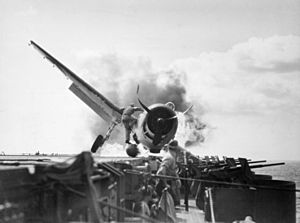
Back in Action
Enterprise returned to duty by November 1943. She supported U.S. soldiers landing on Makin Atoll from November 19–21, 1943.
Enterprise launched planes to strike the Marshall Islands. She helped U.S. soldiers land on Kwajalein from January 29 to February 3, 1944. Then she attacked the Japanese base in Truk Lagoon in the Caroline Islands on February 17.
Enterprise also launched planes to hit Jaluit Atoll on February 20. She helped troops who were landing on Emirau Island (March 19–25). On April 14, she helped troops land in Hollandia (now Jayapura), in New Guinea.
The Philippine Sea Battle
On June 19, 1944, Enterprise took part in the Battle of the Philippine Sea. American and Japanese pilots fought for over eight hours. Over two days, six American ships were damaged. The U.S. lost 130 planes and 76 pilots. However, American aircraft and submarines sank three Japanese carriers: Hiyō, Shōkaku, and Taihō. The Japanese lost a massive 426 planes.
Enterprise helped defend U.S. ships and attack Japanese ships. After the battle, she helped with the invasion of Saipan until July 5. She then returned to Pearl Harbor for a month of rest. She came back on August 24 and attacked the Bonin Islands from August 31 to September 2.
Leyte Gulf: A Major Victory
In the Battle of Leyte Gulf (October 23–26), Enterprise planes attacked Japanese battleships and destroyers. During November, her planes hit Manila and Yap. She returned to Pearl Harbor on December 6, 1944.
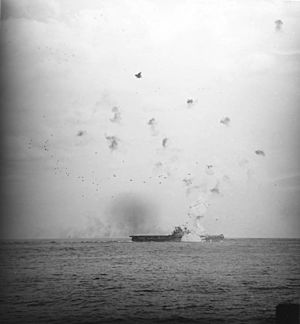
After the War: Coming Home
Operation Magic Carpet
After the war, Enterprise sailed to Pearl Harbor with 1,100 soldiers. Then she began sailing to Europe. She brought 10,000 soldiers home as part of "Operation Magic Carpet." During her last trip, the ship faced very high winds in the Atlantic. The crew almost had to abandon ship. Enterprise had to return to New York.
Enterprise received a special British Admiralty Pennant. This pennant was a gift from an ally. Enterprise is the only non-Royal Navy ship to get this award in over 400 years.
The End of the "Big E"
Enterprise entered the New York Naval Shipyard on January 18, 1946. She was being prepared to be taken out of service. In 1946, there was a plan to give her to New York State to be a memorial. However, this plan was canceled in 1949. The "Big E" was sold on July 1, 1958, to the Lipsett Corporation to be scrapped, meaning taken apart for materials. This process was finished in May 1960.
New Enterprise Ships
In November 1961, USS Enterprise (CVA(N)-65) was put into service. This was the world's first nuclear-powered aircraft carrier. The Enterprise (CVN-65) was taken out of service on December 1, 2012. Another Enterprise will be a Gerald R. Ford-class aircraft carrier, CVN-80.
Awards and Honors
Enterprise received a Presidential Unit Citation for her amazing service during World War II. This award is given for outstanding performance in battle. The citation says:
For consistently outstanding performance and distinguished achievement during repeated action against enemy Japanese forces in the Pacific war area, 7 December 1941, to 15 November 1942. Participating in nearly every major carrier engagement in the first year of the war, the Enterprise and her air group, exclusive of far-flung destruction of hostile shore installations throughout the battle area, did sink or damage on her own a total of 35 Japanese vessels and shot down a total of 185 Japanese aircraft. Her aggressive spirit and superb combat efficiency are fitting tribute to the officers and men who so gallantly established her as an ahead bulwark in the defense of the American nation.
Enterprise also earned the Navy Unit Commendation and 20 battle stars for her World War II service. This makes her the most decorated U.S. Navy ship ever.
- This article incorporates text from the public domain Dictionary of American Naval Fighting Ships.
- The Big E: The story of the USS Enterprise, by Edward P Stafford, (1962)
- "Enterprise: America's Fightingest Ship and the Men Who Helped Win World War II," by Barrett Tillman (2012).
Images for kids
See also
 In Spanish: USS Enterprise (CV-6) para niños
In Spanish: USS Enterprise (CV-6) para niños


